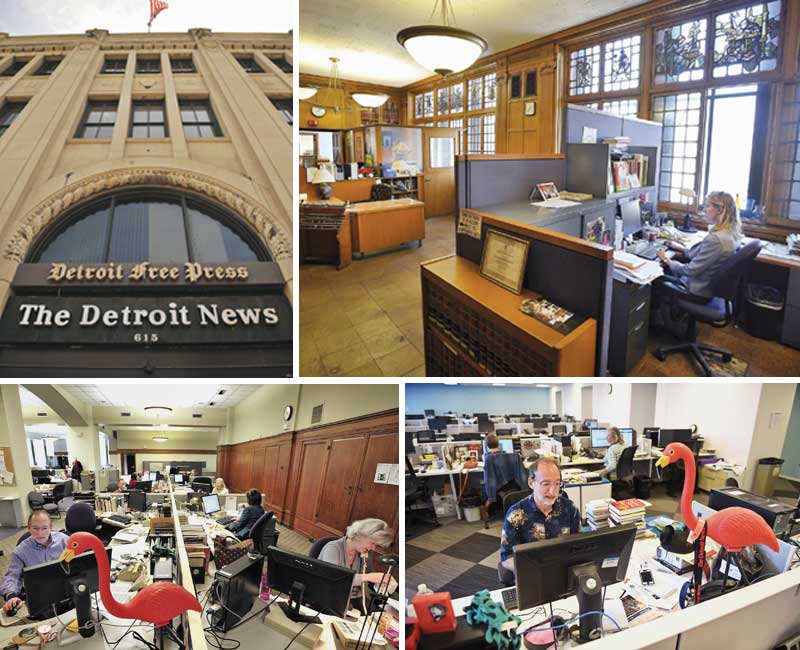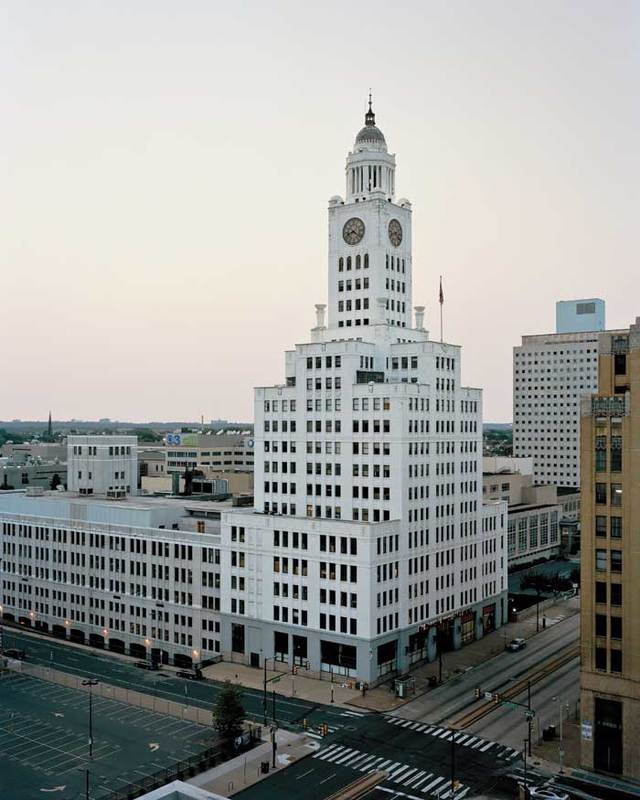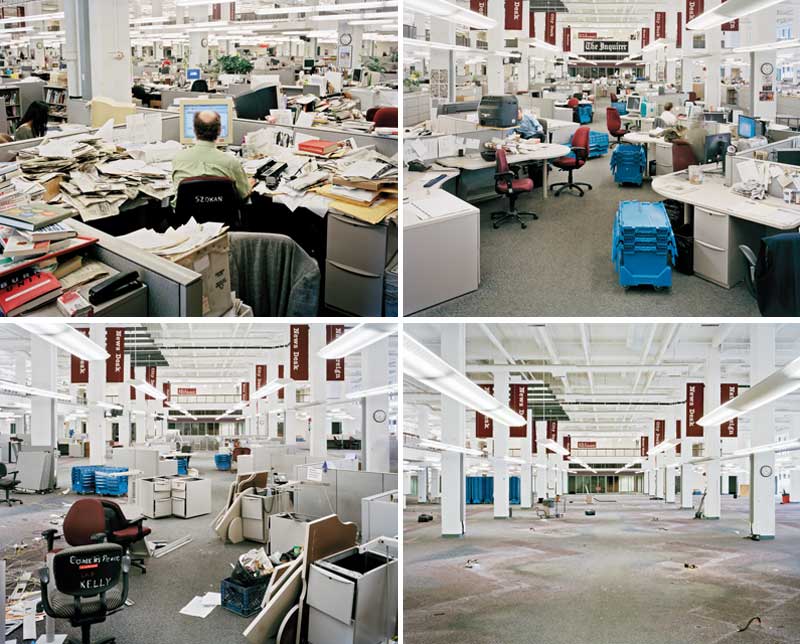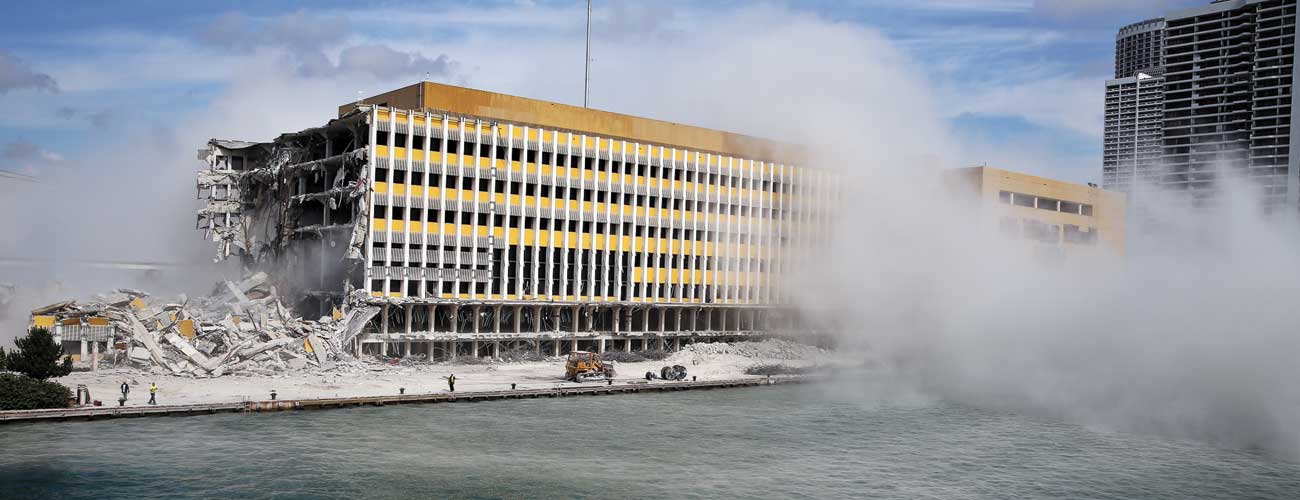The building at 615 W. Lafayette Blvd. looms above the Detroit street like a castle, its concrete facade commanding an entire city block. Carved above its top windows, figures of Franklin, Gutenberg, and other masters stand guard over the structure’s front entrance, where letters reading “The Detroit News” and “Detroit Free Press” span a half-moon arch. Raised inscriptions lining the parapet remind passersby of the building’s original intent: “SCOURGE OF EVIL DOERS,” one reads. “EXPOSER OF SECRET INIQUITIES. . . UNRELENTING FOE OF PRIVILEGE AND CORRUPTION.”
A health insurance company now inhabits the building’s top floor; the papers have moved out. The other floors sit empty, awaiting new tenants.
The News and Free Press consolidated business operations under the Detroit Media Partnership in 1989, and then atrophied like so many of their counterparts over the past decade. The company sold the building last year to a billionaire who’s bought up much of downtown. The newspapers’ staff were too pared down in the digital age to take up so much room.
The relocation required The News, for which the W. Lafayette headquarters was constructed nearly a century ago, to part with a piece of its soul. History oozed from the building’s ornate architecture—signs of the glory days could be found around every corner.

Clockwise from top left: The front entrance of the former Detroit News and Free Press building (John T. Greilick); Detroit News editorial writer Ingrid Jacques works in the former building’s fourth floor editorial board offices (Daniel Mears); Detroit News columnist Neal Rubin’s desk at the News’ current offices (Max Ortiz); Rubin, at left, works in the former third-floor newsroom (Daniel Mears)
The News and Free Press now rent space in a decidedly less extravagant building owned by the same local billionaire. It sits near a downtown core in the early stages of revival. The newsrooms have open floor plans typical of many modern offices, and digital editors and producers are centrally located to ease breaking news coverage. The organizations continue to produce meaningful work in a city that urgently needs it, and their digital audience has consistently grown in recent years.
“It’s weird working in someone else’s building, where we’re tenants,” said John Gallagher, a Free Press business reporter. “But you’ve got your keyboard and your pen and your notepad—what more do you need?”
Still, the smaller confines are an ongoing reminder of the newspapers’ diminished impact on civic affairs. The longtime dailies reduced home delivery to three times a week in 2009, just as the financial downturn ravaged the city and municipal bankruptcy loomed on the horizon. Today, in an age dominated by social media, the papers are no longer the preeminent voice sharing news from on high. The monument on W. Lafayette Boulevard was a symbol of institutional vitality that withered. Small wonder that the building inspires nostalgia.
Alan Stamm, a longtime News editor until 2003, didn’t visit the old newsroom before the paper relocated. “I want to remember it the way I remember it,” he said. When Stamm occasionally passes the building as he drives through the city, he thinks about the stairway leading up from the lobby, its stone steps worn smooth by journalists hurrying out on assignment, or hurrying back to make deadline. “You were literally walking in the footsteps of those who went before you,” he said. “You could see it.”
Those days have long since passed. After more than a decade of upheaval, the way forward for newspapers remains unclear. Attempts to adapt their business models to the new environment have mostly proven wildly unsuccessful—at times disastrous—and even the most innovative organizations have struggled to keep revenue up.
‘It’s weird working in someone else’s building, where we’re tenants. But you’ve got your keyboard and your pen and your notepad—what more do you need?’
With dwindling financial resources available for newsrooms, most have had to cobble together their remaining assets to stay afloat. The sale of newspaper headquarters has become commonplace for many metropolitan dailies. And for many journalists, gazing upward at buildings now populated by healthcare companies, tech startups, or hotels, it’s the most tangible symbol yet of their diminished role in American society.
But saying goodbye also frees news organizations from the weight of the past. To a younger generation accustomed to digital agility and newsroom austerity, the palatial structures convey self-indulgence and bureaucratic inertia. New offices are tailored for the immediacy of online publishing, not to mention whittled staffs. What’s more, by letting go of past vestiges, outlets have freed up cash to reinvest in journalism and technology.
“If the message now for metropolitan newsrooms is digital innovation, then it may be necessary to create a very explicit break with the past,” writes Nikki Usher, a George Washington University professor who studied newsroom shifts in a report for the Tow Center for Digital Journalism at Columbia University. “New stories need to be created to establish a new narrative about the purpose and mission of journalism.”
The internet allows people to both bypass the geographical restrictions of accessing journalism and to consume that journalism in digital forms. So it’s only fitting that the physical manifestations of media have lost meaning, too. The great challenge for newsrooms going forward is to build, in whatever form, a new home in the communities they serve.
Today, former newspaper properties dot the United States like far-flung stops on a transcontinental road trip. From Seattle, where the Seattle Times in 2011 vacated its building of 81 years, a 12-hour drive south on Interstate 5 leads to San Jose, home to the Mercury News, which sold its complex to a computer manufacturer in 2013. Continuing into Southern California will eventually lead to the Riverside Press Enterprise’s old stomping grounds, opened in 2007 and pawned off six years later. After veering east, through the deserts of Arizona, New Mexico, and West Texas, the Fort Worth Star-Telegram’s historic headquarters will eventually come into view near the center of town. It was sold four years ago.
The next stop is metropolitan Atlanta, where the Journal-Constitution moved outside of city limits in 2010. A detour north, into the Midwest, will take you past the former digs of the Cleveland Plain Dealer, Chicago Sun-Times, and Minneapolis Star Tribune. If you head east along the Atlantic coastline, you’ll hit another batch of shrines to better days: those of the Asbury Park Press and Newark Star-Ledger in New Jersey; the Journal News in Westchester, New York; and the Providence Journal in Rhode Island.
The tour concludes in Portland, Maine, where the Press Herald once resided across the street from City Hall. The newspaper’s sale in April was its fourth in 17 years—a period that has seen precipitous declines in staff and circulation despite periodic, though fleeting, rounds of reinvestment. The Press Herald’s parent company sold its downtown building in 2009, and in May a 110-room newspaper-themed hotel opened in its place.
The Press Hotel’s bar is dubbed The Inkwell, while antique typewriters protrude from a lobby wall and metal typesetting serves as a backdrop to the front desk. The only remaining signs of the Press Herald are the bronze letters still gracing the building’s exterior and the complimentary newspapers given to guests each morning.
“[The theme] seemed an obvious approach to really recognize the history of the building and what the occupants of that building meant to the local community. It was a place to be in the know,” said Jim Brady, the Press Hotel’s developer. “It gives off a sense of power.”
The journalists who worked inside such buildings fed off that perception, mythologizing their own role as a bedrock of free society—the Fourth Estate. To them, the structures exuded a clear duty to provide the public the information it deserved. And that self-importance fueled them at work each day, as the late Los Angeles Times columnist Al Martinez explained in his 2007 reflection on the former Oakland Tribune newsroom where he once worked.
“We were a brotherhood of young lions back then, working hard through a half-dozen deadlines a day and drinking hard” at night, Martinez wrote. “We did it, we told ourselves, for the people’s right to know, and affixed it like a knight’s pennant to the end of a spear.”
This job isn’t as noble as it seems, most journalists would admit, but it’s as noble as any job is going to get. The real reason it’s so difficult to let go to of aging buildings is that they’re relics of an era in which journalism was simply a calling, not a struggling business with corporate ownership, quarterly earnings reports, not enough money coming in, and too many journalists going out. The physical structures remind us of a time when those in our profession felt in control of their own destiny.

The Philadelphia Inquirer building, the “Tower of Truth,” in 2012. (Will Steacy)
Newspapers erected these grand edifices as tributes to their 20th-century civic influence—real and perceived. The buildings often had on-site printing presses, adding the machinery’s low hum to already buzzing newsrooms, and affording residents the opportunity to see a newspaper being made. The properties were a physical link between journalists and the communities they covered, the ultimate branding tool. Their dazzling architecture and mammoth scale sometimes rivaled those of government buildings or other institutions, showcasing newspapers’ prominent place in the community.
This lavishness was created with scrupulous intention. In 1922, for example, the Chicago Tribune sponsored an international design competition seeking “the most beautiful and distinctive office building in the world.” The 36-floor, neo-Gothic Tribune Tower was finished three years later, complete with gargoyles and flying buttresses reminiscent of those on a European cathedral. “Its unusual character and beauty will make it a national landmark from coast to coast,” the monthly Real Estate News gushed. The cost was $8.5 million, equivalent to roughly $116 million today, a testament to the newspaper’s financial security.
News organizations back then expected the good times to last and their role in society to continue. Towering headquarters like the Tribune’s limestone outpost communicated this sense of permanence to all who passed on the sidewalks below. Journalists walking through that building’s front doors received a similar reminder through the words of Joseph Medill, etched into the lobby: “I want the Tribune to continue to be after I am gone as it has been under my directions: an advocate of political and moral progress, and in all things to follow the line of common sense.”
The newspaper’s employees may still gaze up at Medill’s words. But the immutability is gone. During the recession, the Tribune Co. flirted with selling the building before real estate prices plummeted. The property sits along the Magnificent Mile, Chicago’s tourist-retail spine and some of the most expensive land in the city. The windfall from a sale could very well have provided a much-needed shot in the arm for a newspaper company making the digital transition.Yet its namesake Tribune Tower and the journalists inside still keep watch over Michigan Avenue.
The sad twist for newspaper companies is that what were once opulent signs of economic vigor have become, in many cases, their greatest financial assets. Months after the venerable Washington Post sold for $250 million in 2013, for example, its headquarters went for $159 million. Newspapers have been starved for capital just as they need it most, and the sale of such property often frees up cash to invest in new products—or pay down pension funds and other debt.

From left to right, top to bottom: Deputy science and medicine editor Don Sapatkin at his desk in 2009; The main newsroom three weeks before the Inquirer’s move in July 2012; Moving day; The day after. (Will Steacy)
What’s more, such buildings were constructed when staffs were growing and expected to continue doing so. But the number of jobs at daily newspapers has plummeted more than 40 percent since 2001, according to the American Society of News Editors, dropping from 56,400 to 32,900. At the same time, many in-house production facilities have grown outdated, underutilized, or redundant through corporate consolidation.
Last year, Digital First Media, one of the largest newspaper chains in the country, put 51 properties on the market. TEGNA, formerly known as Gannett, sold its Virginia headquarters in July, raking in a cool $270 million. McClatchy Co. sold the Miami Herald’s iconic oceanfront location for $236 million in 2011.
“This is not the newspaper industry anymore,” said Paul Anger, who retired in May as editor and publisher of the Detroit Free Press. “It’s the publishing industry. And when you’re in a building that really doesn’t serve your needs anymore—there could be open space, configurations that don’t work for you, equipment or costs that don’t make sense—moving somewhere new is starting fresh.”
What Anger says is true, though also easier said than done. Any company would have a hard time parting with its home of decades, especially if that home was iconic. When newspapers leave their headquarters behind, they require journalists to take a leap of faith. Renting, not owning, new office space stokes fears of transience. Such moves, furthermore, demand that individuals seal away memories and begin the long task of constructing a new sense of self. The potential benefits may ultimately outweigh the downsides. But continued instability precludes many old media companies from forging a digital identity.
The Philadelphia Inquirer not only boasted an eponymous, pearl-white building topped by a four-faced clock and brass dome, but the building carried a nickname that reflected the paper’s ambitions: the Tower of Truth. It won 17 Pulitzer Prizes between 1975 and 1990. Newsroom manpower reached upward of 600. Veteran reporters today still reminisce about the globe hanging in the building’s lobby, which hinted at both the Inquirer’s reach and the universality of its mission.
The pressroom at the base of the tower was converted into a larger, shinier newsroom at the peak of the paper’s reign. “We moved there in 1997, right, ironically, as things were starting to contract,” said Michael Vitez, a staff writer since 1985. “I thought it was too big. It was beautiful, but it wasn’t a well designed work space.” Dwindling circulation and revenues led to deferred maintenance and massive staff cuts, which turned some corners of the newsroom into wastelands of empty desks. The falling fortunes culminated in bankruptcy in 2009, though the Tower of Truth still connoted a history shared by the journalists who worked inside.
“It was our building,” Vitez said. “It was the Philadelphia Inquirer building. It stood for something.”
In 2011, however, the news organization’s parent company sold the structure to a real estate developer for a reported $23 million. The humbled outlet and its sister newspaper, the Philadelphia Daily News, moved to the third floor of a former Strawbridge & Clothier outpost. The new space enables a more collaborative work environment and is better suited to current staff levels. It also sits in a bustling part of the city. Still, Vitez added, “we’re a tenant in a department store.”
New York photographer Will Steacy, whose father worked at the Inquirer for 29 years, captured some of the transition in his book, Deadline, slated for release in September. Though Steacy set out with the goal of chronicling the paper’s rebound from bankruptcy for one year, he ended up witnessing a life-or-death battle that’s continued for a half-decade. “Resilience and the ability to fight through difficult times are ingrained in all of us,” Steacy said. “It’s the human condition.”
The journalists who remain, like Vitez, are survivors. The question now is whether they can become innovators, a task inherently more difficult given the industry’s continued volatility.
After the Inquirer departed the Tower of Truth, Inga Saffron, the newspaper’s architecture critic, was optimistic that it could forge a new identity elsewhere. “Making our home in a newspaper building froze us psychologically in history, and kept us from interacting physically in the city,” she wrote in a 2012 Inquirer column. “The future for all media is an interactive one.” In that environment, she added the next year in a New Republic piece, “the most valuable real estate is online.”
That argument is unimpeachable. Yet Saffron conceded in August that the Inquirer hasn’t made the strides she expected to be catalyzed by the change of location. It and the Daily News had been sold fives times in the six years leading up to their move. And the three years since then haven’t seen an end to the turmoil: The Inquirer’s publisher in 2013 unfairly fired its editor, whom a judge then reinstated with a court order; the next year, a new owner died in a plane crash just a week after acquiring the parent company; staff cuts have continued.
“Our hopefulness about us becoming more digitally savvy—we’re making slow progress,” Saffron said in an interview. “But I guess you could say our slowness has more to do with our never-ending soap opera.”
Reacting to such unpredictability leaves journalists fewer chances to come up for air. The Des Moines Register, which left its headquarters of 95 years in 2013, is one of many that has honed its newsroom design to help ease the transition to digital—not to mention make its office appear fit for the 21st century.
The Register’s space is open, bright, and less than half the size of its predecessor. “You definitely feel that you’re walking into a modern workspace,” said Kelli Brown, senior news director for digital. Web producers and section editors sit in a central hub dubbed “mission control” so they can interact more easily in breaking news situations. Planning meetings now take place in the open newsroom—not a separate conference room—and boards used to sketch out publishing schedules are in plain view. Along with a bevy of TVs rolling both local and national feeds, a “blueboard” of monitors displays the Register’s Web analytics in real time.
“It’s all much more front and center,” Brown said. “A reporter—anyone—can notice. There are times when you’re sitting at your desk and you notice that 600 people are on a story [simultaneously]. So it’s like, ‘What did we do right there?’ ”
The Detroit News and Free Press’ new offices, where they moved last October, have similarly improved designs. “The tighter quarters does help the energy level,” Marti Davenport, the former’s news editor, wrote in an email. “It fosters more person-to-person communication,” added Brian Manzullo, a sports Web editor at the Free Press.
When the 28-year-old Manzullo joined the news organization in 2012, its building was a maze of dark corridors and empty desks. “We all know what’s happening. We all know that newsrooms are declining,” he said. “We had to try something new, get closer to downtown and get a breath of fresh air.”
Such new offices certainly won’t solve newspaper companies’ long-term financial problems. But they’re a symbolic step forward into the unknown, an acknowledgement that there’s no going back to what came before, however glorious it was. The resulting psychological benefits can’t be overstated, especially for the younger generation on whose shoulders the fate of journalism rests. If the companies that formerly produced only newspapers have any chance of survival, they will need that energy—not the baggage that accompanied vaunted historical headquarters.
The market today is more stable than it was five years ago. And metro news organizations attempting to prove their vigor point to ballooning digital audiences and investment in new products as evidence of their vitality—fair arguments, certainly. But neither of those barometers addresses the structural defects of the news business today. Neither instills faith that companies will be able to achieve the financial security or community stature embodied by newspapers’ ostentatious buildings of the past.
In Detroit, the newspapers’ gleaming, rented offices sit in a city core witnessing a nascent recovery. “Moving into this new space, we feel more connected to the heart of downtown,” said Kathy Kieliszewski, director of photography and video at the Free Press. The hope is that journalists working there can carve out digital real estate within the community, and that residents will in turn feel more connected to the outlets. The two competitors are betting that their recent optimism in those regards—and not the broader, decades-long trends shrouding them—will live up to another inscription atop their former headquarters: “HERALD OF WHAT IS TO COME.”
David Uberti is a writer in New York. He was previously a media reporter for Gizmodo Media Group and a staff writer for CJR. Follow him on Twitter @DavidUberti.

